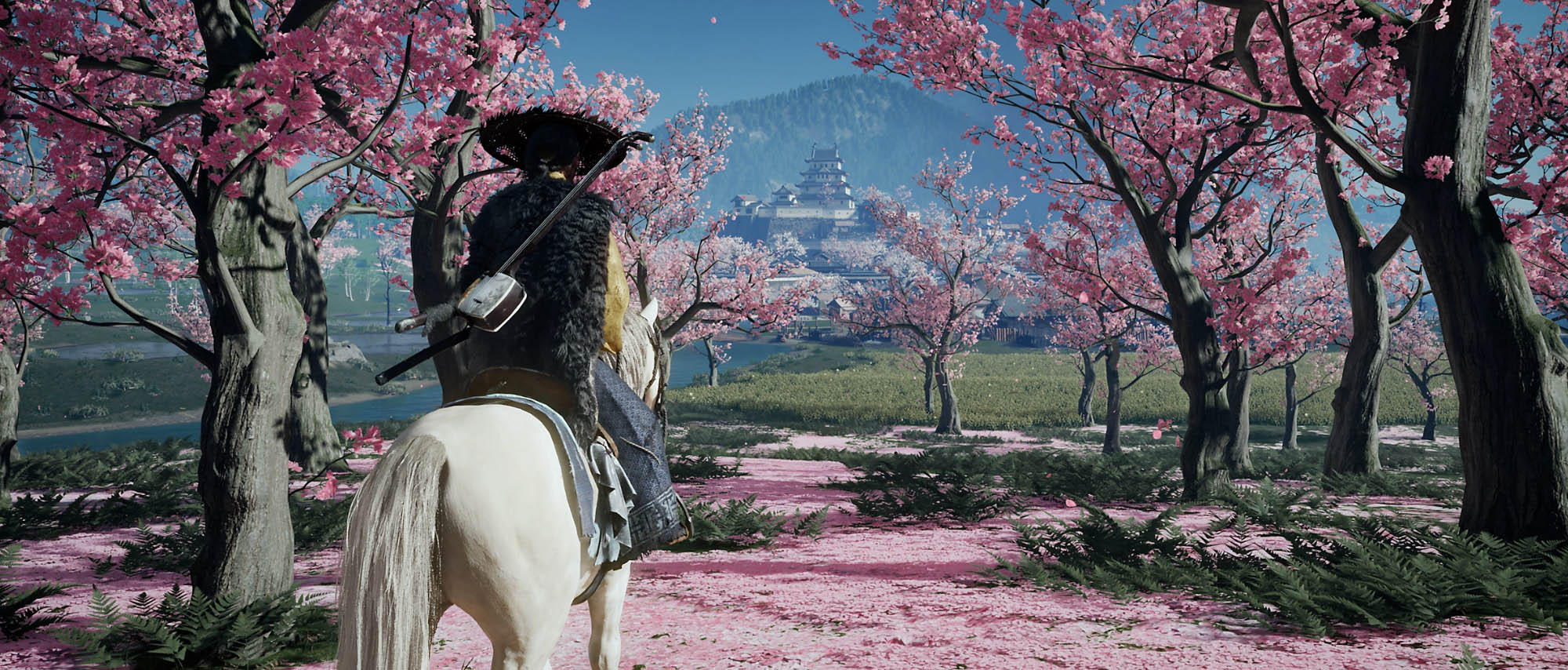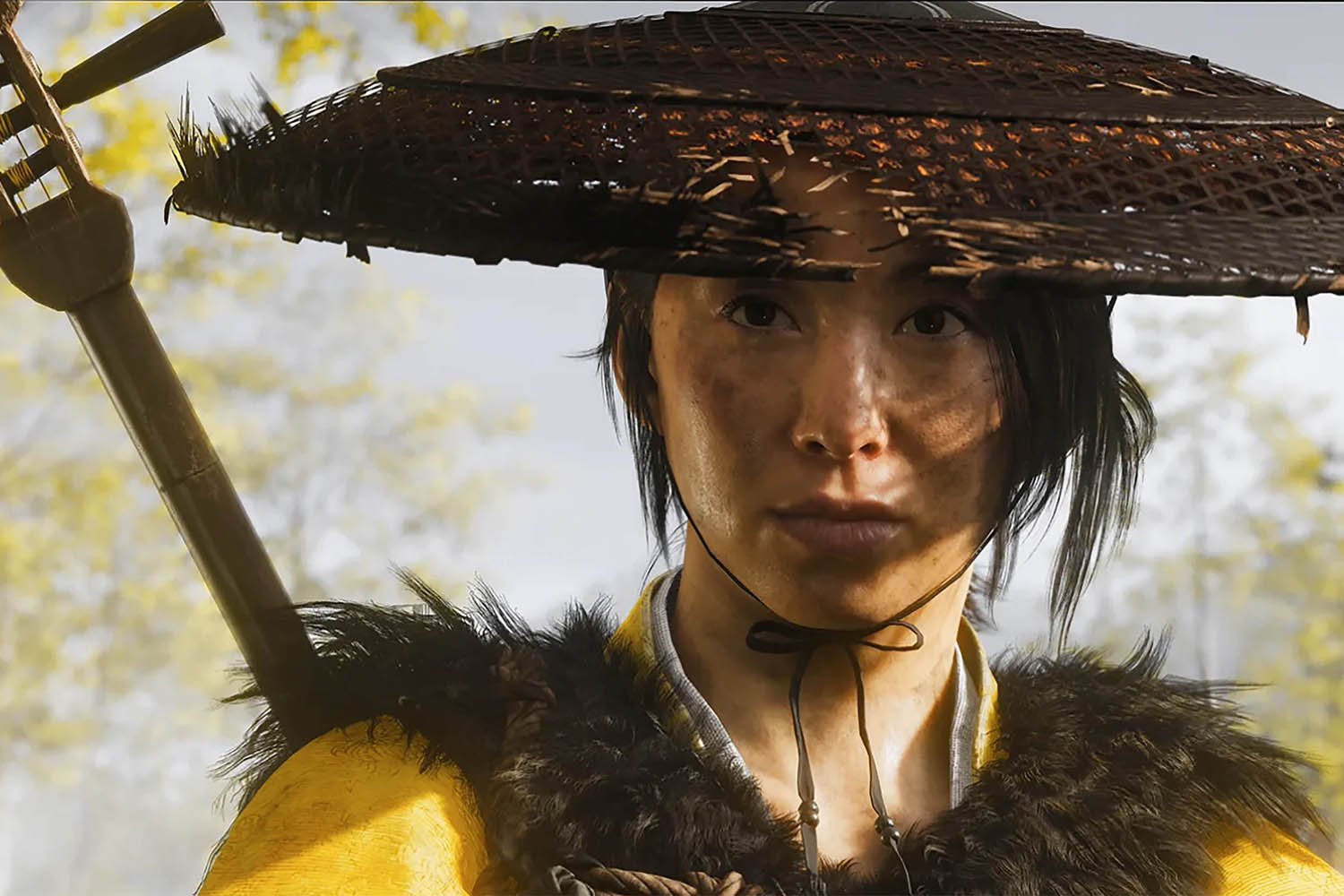There is a moment deep into Ghost of Yōtei, Sony’s latest blockbuster video game, when Atsu, a ronin (the Japanese term for a wandering mercenary), must pose as a waitress. The disguise is meant to place her near her target, who is drinking sake in a roadside inn. If the story were written 30 years ago, we might expect the masquerade to end in revelation; setting down her armour and blades, she would be revealed, like the high school outcast removing her glasses, to have been beautiful and feminine all along. Not so here.
Atsu is manifestly unsuited to the part. Her life has been shaped by violence: as a child she watched her blacksmith father and shamisen-playing mother murdered at the family’s Hokkaido homestead. Atsu’s desire for revenge has shaped not only her days, but also her features. When, at the door to the inn, her co-conspirator winces at her awkwardness in a kimono, Atsu snaps back: “I can’t change my face.”
Neither, it seems, can she escape her foundational trauma. She bears it literally on her body, in bandages inscribed with the names of the Yōtei Six, the masked figures responsible for her parents’ deaths. In the game’s opening scenes, you trace each one in calligraphic strokes across the PlayStation controller’s touchpad, a gesture that feels more ceremonial than mechanical. The cloth marks the psychic wound always visible on Atsu’s body. Then, as her legend extends across the countryside, she becomes known locally by the nickname onryō – the folklore name for a vengeful spirit, usually a wronged woman hellbent on exacting retribution.
It is a rare case in which the myth equals the woman. Atsu’s brand of justice is both extravagant and inventive. Under the tutelage of eccentric masters whose homes she visits one by one, she soon acquires a repertoire of weapons: paired blades, the long ōdachi used against towering foes, the spear-like yari, the chain-sickle kusarigama, swung with unnerving grace. Each has its utility, and Atsu shifts between them according to circumstance, slowly mastering their rhythms. She creeps through reeds, cutting down anyone who stands between her and her quarry, arterial spray marking the snow in Pollock-style flecks. She leaves in her wake an apocalyptic trail of twitching bodies.
In this sense, the game belongs squarely to the tradition of Japanese exploitation cinema: Lady Snowblood, for example, of the Hanzo the Razor trilogy – films in which revenge is rendered as a stylised art form. But, as with Quentin Tarantino’s Kill Bill, the spectacle of western artists working within such a culturally specific genre raises questions of ownership and appropriation.
Related articles:
“Sucker Punch is an American studio, and we know we don’t come from that cultural background,” co-director Nate Fox told me. His team surrounded itself with Japanese advisers, striving for authenticity. The studio has faced down such scrutiny before. Its earlier game, Ghost of Tsushima, told of samurai resistance to Mongol invaders in the 13th century. Praised for both its craftsmanship and its conscientious treatment of place and culture, the game was celebrated beyond the critics’ circle: officials on real-life Tsushima Island named the developers permanent tourism ambassadors.
With Yōtei, Sucker Punch has extended its canvas northward and its chronology forward several centuries. In the 17th century Hokkaido – Ezo, as it was then known – was a wilderness at the edge of the Japanese empire, a place on the margins, geographically and politically. Peace on the mainland had left many ronin unemployed; the frontier promised danger, lawlessness and opportunity.
For Fox and his collaborators, the region was an equally irresistible stage, and not only for its politics. “Hokkaido is one of the most beautiful and varied landscapes in Japan,” he said. There is much diversion in Yōtei’s world designed to show off these landscapes. Birds and foxes draw the player towards dens or hilltop caches holding upgrades and rare items. New costumes are unlocked through puzzles, then refined by dye specialists, each devoted to a single hue. Other interludes, such as quiet foraging trips, gambling in roadside inns or sketching pastoral scenes, offset the intensity of combat with gentler pursuits.

‘Both games dwell on Japan’s changing seasons: pink blossom petals drift in spring, sunlight tinsels on a summer stream’
Some of these elements will feel familiar, not only to players of Sucker Punch’s earlier work but to anyone who played Ubisoft’s Assassin’s Creed: Shadows, another expensively produced samurai game released earlier this year. While the two games take distinct approaches to the Sengoku period, their aesthetics overlap. Both games dwell on Japan’s changing seasons: pink blossom petals drift in spring, sunlight tinsels on a summer stream, leaves eddy in autumn, snow crunches pleasingly in winter.
The two games also share, less happily, a brush with the culture wars: commentators who, for more than a decade, have sought to turn video games into a political battleground, a recruiting ground for grievances, and a way to radicalise young players who might approach games as a lens through which to parse the world. Shadows cast players as Yasuke, an African man who rose from slavery to serve as a samurai. He is a fictionalised rendering of a historical figure who, like Atsu, pursues powerful targets. Online provocateurs dismissed the choice as “woke”, as though his presence existed only to satisfy a diversity quota. Still, the manufactured outcry grew loud enough to draw a rebuttal from the historian Yu Hirayama, who stated that there was “no doubt” Yasuke was a samurai.
Ghost of Yōtei has drawn similar ire for placing a woman at its centre. In today’s febrile online atmosphere, even such a benign decision risks culture wars conscription, where the gender of a protagonist is treated by some as a political statement rather than a creative one. That a woman can carry a sword, or a story, still seems to require defending. For Fox, it was an easy decision. “Atsu is somebody who the other warriors in Ezo just don’t think is going to be able to stand up to them,” he said.
Few figures in 17th-century Ezo would have been granted less authority than a young woman seeking vengeance, and victories from the underdog position, Fox argues, are always more satisfying. Atsu’s sex is presented as neither a gimmick nor a concession; it’s simply the ground from which her legend grows. When she disrobes to bathe in hot springs, she does so in the same manner as Jin, the protagonist of Ghost of Tsushima: pragmatically and without a hint of titillation.
Neither Shadows nor Yōtei are serious works of non-fiction, of course, but both meet the threshold for works of public-facing history. Fox, however, resists the idea that his team are protectors of Japanese history. “We’re making fictional stories,” he told me, “not a stone-for-stone reproduction.” The distinction is important. Ghost of Yōtei is not a museum piece but an homage. Yet the developers remain keenly aware of the risks of caricature. Advisers were consulted throughout, and Sony’s Tokyo office provided feedback on scripts, animations and sets. The result is a form of cultural stewardship by proxy: not the custodianship of archivists, but of a dramatist’s consideration of the weight of their material.
As part of these efforts, the team included the Ainu, the Indigenous people of northern Japan. Often absent from popular depictions of Japanese history, the Ainu lived in Hokkaido long before the island was absorbed into the Japanese state, and their presence here is more than decorative. Sucker Punch consulted cultural advisers and incorporated details inspired by lived practices, some drawn from a day spent with an Ainu family. The decision places Yōtei in delicate territory: it broadens the historical canvas, offering a glimpse of a culture seldom represented in mainstream media, yet risks reducing that culture to backdrop. The game embeds the Ainu in specific missions, exploring not only customs, but family rifts, complicating dynamics that render the group as more than historical décor, giving them presence as characters with their own motives and contradictions.
When I asked Fox what the team drew on in writing Atsu’s story – a tale that begins with the spectacle of childhood trauma – he was quick to deflect. “I’m happy to say I was never pinned to a tree with a sword,” he joked. The quip gestures to the reliance here on genre tradition rather than lived experience. Ghost of Yōtei works within the grammar of revenge cinema, where trauma is less a psychological condition than a narrative engine. Yet the game lingers on it with unusual care. Atsu’s grief is not discarded after the prologue; it is woven into mechanics, and all of the melancholic interactions that follow.
The effect is both stylised and sincere: trauma becomes motif, repeated until it accrues texture, inviting the player to consider not only the catharsis of revenge but the cost of carrying its memory. And, just as the developers allow themselves some freedom from historical fact, so too does their story slip the strictures of vengeance. There is room in Atsu’s character for mercy if not forgiveness – a message that feels especially pointed not only in this historical setting, but also in our own.


